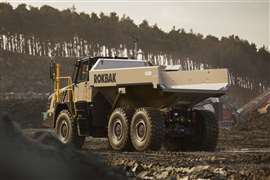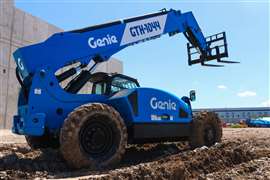Foundations: from the ground up
07 November 2012

While this year has seen new equipment launched in the foundations sector, existing equipment has also been tested in new ways on a host of challenging projects around Europe.
Manufacturers of foundation equipment must produce equipment that is robust and reliable enough to be capable of working in hostile environments – at altitude, in poor soil conditions or even over water.
In addition, such equipment must be as flexible and, in some instances, as compact as possible to be able to perform a wide range of tasks in sometimes tight working conditions like city centres.
Environmental concerns must also be taken on board, with many of the latest machines featuring new, low emissions engines, as well as a focus on reduced vibration and the introduction of energy-saving modes.
In certain circumstances, no emissions can be allowed on the construction site, necessitating the development of electrically-powered equipment.
Soilmec, for instance, has introduced a new electric multipurpose drill rig – the SM-5E – for work in tunnels or other restricted spaces where diesel engine emissions would be harmful.
The SM-5E comes directly from the SM-5 and has the same main features, including rotary heads with torque ranging from 687 to 972daNm, and maximum drilling speeds of between 98 and 862rpm. The power source, however, has been changed to a 75kW ABB electric engine.
As well as its compact design, the SM-5 is also a multipurpose machine – its optimised mast articulation and large range of rotary heads ensures that it covers a broad application field from anchoring and tiebacks to micro-piles, jet grouting (fitted with a special extension), coring, water well drilling, tunnelling and radial soil consolidation.
The new rig and its electric counterpart is the result of a collaboration between Soilmec technological research and sister-company the Trevi Group, which brought its jobsite experience to the Soilmec designers.
Meanwhile, Soilmec has also responded to customer demand for increased versatility with the launch of the SF-65 continuous flight auger rig.
The upper structure of the SF-65 is mounted on base carrier with extendable crawler frames and turret, and the rig can rotate 360° to allow for the best possible working area.
Soilmec has introduced a new, telescopic mast that features two hydraulically sliding parts. This is said to provide a more compact rig to allow for easier transport as none of the components have to be disassembled.
The SF-65 is also equipped with Soilmec’s Drilling Mate System (DMS), on a 305mm touch screen. This technology allows users to monitor and control the operating parameters on the self-erecting rig, which is powered by a 205kW diesel engine and can handle 1m diameters to a depth of 27m.
Technology's key role
Technology is also playing a key role in the latest developments. Take PVE’s Ecostrike hydraulic piling hammer, for example, which is available with the company’s Measurestrike system for regulating and recording impact parameters.
As well as allowing contractors to document their work, this means the hammer is suitable for a range of applications, including pre-cast concrete piles, steel casings and profiles, wood piles and combi piles.
Features of the hammer include a low wear cylinder assembly, shock-resistant electrical connectors, accelerated or free fall modes, and high frequency operation if required.
PVE also says the machine is 25% quieter than its predecessor, while using the accelerator mode is said to increase efficiency by 20%. The Ecostrike hammers are available with 3 to 40 tonne drop weights.
Specialist applications are another area of current development. BSP, for instance, has introduced a new DX-RT piling hammer for driving steel piles which support electrification stanchions, gantries and other railway projects.
The DX-RT has been designed as an attachment for mounting on road/rail hydraulic excavators with an operating weight of around 30 tonnes. When mounted to the machine’s bucket linkage, the hammer also has a tilt range of 5° to allow it to cope with the cant of the rail lines.
Two models are available, the DX-RT 20 and the larger DX-RT 25, which offer ram weights of 1.5 tonnes and 2 tonnes. Maximum impact energy is 20kNm and 25kNm respectively while blow rate at rated energy for both models is 80 blows per minute.
Terrawise Construction, a UK-based civil engineering company, bought one of the first DX-RT hammers produced, and used it to drive piles on the new Manchester Metro rail line linking Oldham and Rochdale in the north of the country.
Terrawise project director James Crossen said, “Piling in a rail environment has one major drawback – restricted access to the worksite. We approached BSP to manufacture and develop the hammer to a specification devised by engineers from various sectors within the rail industry, including designers, plant specialists, piling contractors and Network Rail.
“As a result, and following extensive trials and tests, the new hammer was delivered and commissioned last December and although it has been working on various projects around the country since then, its full potential has recently been realised on the Manchester Metro project.”
Both the new DX-RT hammers can also be used to drive sheet piles, small bearing piles or tubular steel with ultimate load bearing up to 1,800kN depending on site conditions.
IHC Fundex is also developing new foundations technology in the form of the F5000 hydraulic foundation machine for piling and drilling, and hopes to unveil a prototype at next year’s Bauma exhibition.
The F5000 drill and piling rig will be self-erecting with a maximum leader length of 56m. Flexibility is a key design concept, and the machine will feature a fully rotating upper carriage as well as a variable hydraulic pump which makes it possible to operate different functions at the same time.
The machine will also be available with either a 315kW or 565kW Volvo engine, depending on the size of impact hammer or torque demand of the rotary heads. The installation of a power pack will also be possible.
Data processing
Meanwhile, Pile Dynamics has released new accessories and software for its Pile Installation Recorder (PIR) – the PIR Viewer and a new version of its PIRPLOT data processing and reporting software.
The PIR is automated monitoring equipment that records and displays grout volume versus depth, along with other parameters that help the construction of augered cast-in-place and continuous flight auger piles.
The PIR Viewer is a handheld wi-fi device that allows a supervisor or inspector to see, in real time, the information that the PIR is displaying to the operator in the crane cab. This enables the supervisor to stop the crane operator sooner in case there is a concern.
In the past, the pile had to be completed and summary report generated before an inspector could review the installation details, but Pile Dynamics said the PIR Viewer allowed grout return to be flagged with a push of a button, while each pump stroke could also be logged.
Once the pile is completed, this information may be compared to the PIR summary report. Post processing with PIRPLOT is also said to generate presentation-quality tables and graphs for quality assurance and control.
Some of the latest news from jobsites also demonstrates manufacturers’ dedication to increasing the performance of their machines no matter what the conditions.
Productive work cycles are crucial, for instance, and contractors need to drive the piles into the ground as efficiently as possible, in spite of challenging ground conditions. This was highlighted on a project in London, UK, where Miller Piling has been tasked with a £2.2 million (€2.8 million) project to install approximately 1,100 reinforced concrete piles in very poor soil conditions.
The One Tower Bridge development is a Berkeley Homes project that will comprise 374 new apartments, a cultural centre, retail facilities and a health spa, on the site of a former coach-park.
The location, while highly sought-after as an address, has less than ideal ground conditions. To help overcome the risk of the ground collapse during the installation of the rotary-bored piles, Miller used Piletec’s ICE 1423 vibrating hammer to install the temporary steel pile casings.
Miller Piling’s technical manager, James Hayward, said, “Normally we’d screw the temporary casing into position with our rig before boring the pile, placing the reinforcement and pouring the concrete. To maintain the programme commitments, we are using the Piletec hammer to insert the casings before we drill them out. This means the hammer can service two machines simultaneously.”
Mr Hayward added that since some of the casings were up to 12m long, the hammer was suspended from a crane to install the piles. Afterwards, the ICE 1423 was used to lift the casings out of the ground before the concrete had cured.
“Without the vibrating hammer, the process would have been slow and laborious,” said Mr Hayward. He was expecting to be off-site six weeks ahead of schedule.
Difficult soil conditions were also encountered during drilling on a project in Turkey, where contractor Geoteknik used a Liebherr LB 24 rotary drilling rig fitted with a 4-fold Kelly bar to build a foundation pit support.
Because the ground conditions were so challenging, both a Liebherr rock auger AU-P drill and a 780mm diameter Liebherr CB-RB core barrel were used to cut through to allow Geoteknik to complete the job on time.
Transported in one piece
The new compact LB 24 rotary drilling rig can drill diameters of up to 1.9m and depths down to 58m. The basic machine and leader can be transported in one piece with a minimum clearance and transport width of 3.4m.
Technology also plays a role in ensuring the reliability and accuracy of the rig. The LB 24 is equipped with Liebherr’s Litronic control system, which includes programmes for various drilling methods as well as information on service requirements and possible defaults. A modem for remote diagnosis as well as a process data recording system for documentation are also available.
On a challenging infrastructure project in Finland, meanwhile, a Junttan PM 23 long reach pile driving rig was put to work – a machine that already had 10,000 operating hours under its belt without the need for any extraordinary maintenance operations, according to the manufacturer.
Extensive building and reconstruction work is taking place on 26 bridges to the north of the city of Kuopio.
The €90 million project, which also involves constructing new roads and rail track, was commissioned by the Finnish Transport Agency road investments unit, Liikennevirasto, and began in October 2009.
Insinööritoimisto Seppo Rantala is the subcontractor in charge of building the 13 most demanding water and rail bridges in the project, and it selected a Junttan HHK 4SL hydraulic hammer and a Junttan PM 23 long reach piling rig to help with the laying of these foundations.
The 50m span Tikkalansaari rail drawbridge, for instance, features a steel lattice structure that is prefabricated at the site next to the foundations and then transferred the 130m to its place.
Four reinforced concrete underwater moulds form the foundation for the bridge. Within the casting, the piles are reinforced and filled with concrete so that the mould and the installed piles form a solid structure.
Concrete-structured pillars of 25.5m tall were then built on the moulds to function as the support frame for the drawbridge. A single mould structure requires 14 to 16 driven piles, their length varying from 24 to 33m.
The fact that the work was performed over water with a depth of around 10m made the job even more challenging, and work had to be performed from a temporary bridge founded on steel piles.
STAY CONNECTED


Receive the information you need when you need it through our world-leading magazines, newsletters and daily briefings.
CONNECT WITH THE TEAM









